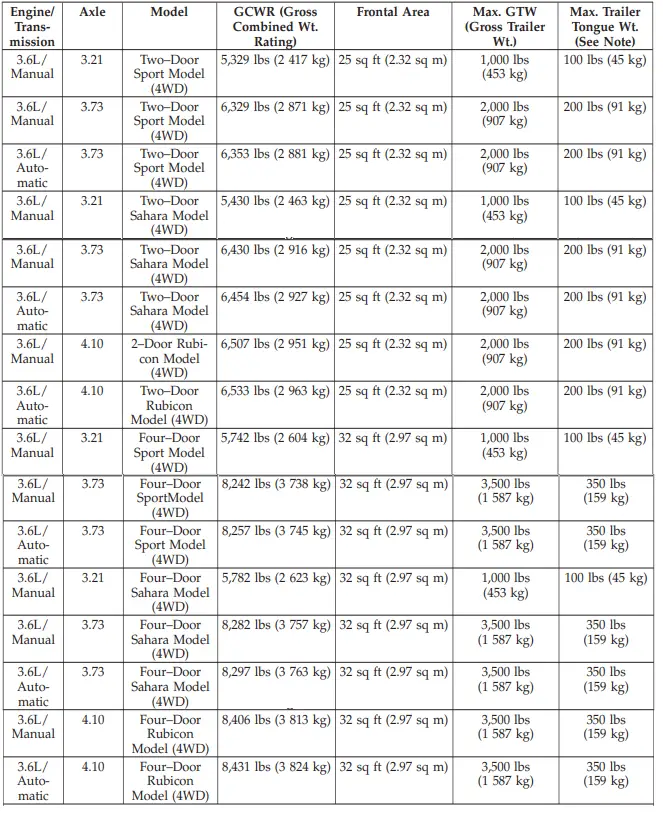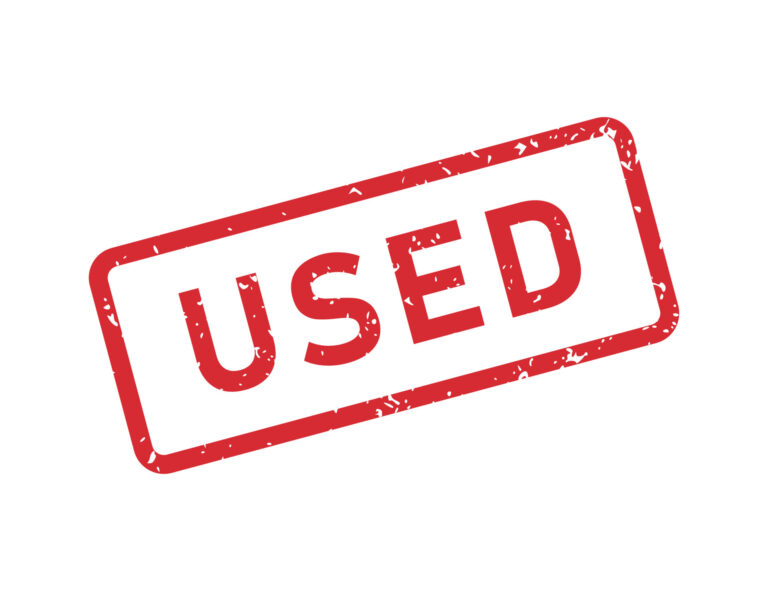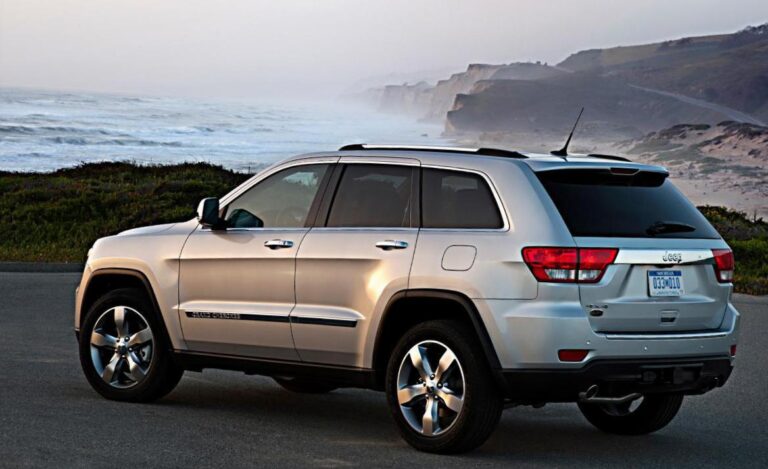Towing With Your Jeep Wrangler: A Comprehensive Guide
Towing With Your Jeep Wrangler: A Comprehensive Guide jeeps.truckstrend.com
The Jeep Wrangler. For many, it’s the quintessential off-road adventure machine, a symbol of freedom and rugged capability. Its iconic design and legendary 4×4 prowess make it the go-to choice for conquering trails and exploring the unbeaten path. But beyond its mud-slinging, rock-crawling reputation, a common question arises: can a Jeep Wrangler tow? And if so, how much, and what does it entail?
While not designed to be a heavy-duty hauler like a full-size pickup truck, the Jeep Wrangler possesses a surprising and often underestimated towing capacity, making it a versatile companion for weekend getaways, hauling recreational toys, or even light utility tasks. Understanding your Wrangler’s specific capabilities and the essential practices for safe towing is crucial. This comprehensive guide will delve into everything you need to know about responsibly and effectively towing with your Jeep Wrangler, transforming it into an even more versatile adventure vehicle.
Towing With Your Jeep Wrangler: A Comprehensive Guide
Understanding Your Wrangler’s Towing Capacity
Before you hitch up anything, the absolute most critical step is to know your specific Jeep Wrangler’s towing capacity. This figure is not universal across all models and generations; it varies significantly based on several factors:
- Generation and Model Year: Newer generations, particularly the JL (2018-present), generally offer higher capacities than older JK (2007-2018) or TJ (1997-2006) models.
- Body Style: The four-door Wrangler Unlimited models typically have a higher towing capacity (up to 3,500 lbs) compared to the two-door models (generally limited to 2,000 lbs). This is due to their longer wheelbase, which provides greater stability.
- Engine Type: Different engine options can influence capacity. For instance, the 3.6L Pentastar V6, 2.0L Turbo, and 3.0L EcoDiesel (available in JL models) each have specific ratings. The EcoDiesel, with its higher torque, can sometimes facilitate higher capacities within the 4-door configuration.
- Transmission: While less of a differentiating factor in modern automatic-dominated lineups, the type of transmission can sometimes play a minor role.
- Axle Ratio: The final drive ratio in your axles (e.g., 3.45, 3.73, 4.10) significantly impacts towing performance and capacity. A numerically higher axle ratio (e.g., 4.10) provides more torque to the wheels, making it better for towing, even if the official maximum capacity remains the same.
- Factory Tow Package: Many Wranglers come with an optional factory tow package, which includes a heavier-duty alternator, upgraded cooling system, trailer hitch receiver, and wiring harness, optimizing the vehicle for towing.

Key Terms to Know:
- Gross Vehicle Weight Rating (GVWR): The maximum permissible weight of the fully loaded vehicle (including passengers, cargo, and tongue weight).
- Gross Combined Weight Rating (GCWR): The maximum permissible weight of the fully loaded vehicle and trailer combined. This is a critical limit for safe towing.
- Gross Axle Weight Rating (GAWR): The maximum weight that can be supported by a single axle (front or rear).
- Tongue Weight: The downward force exerted by the trailer’s coupler on the hitch ball of the tow vehicle. This should typically be 10-15% of the total loaded trailer weight. Too little or too much tongue weight can cause instability and dangerous sway.


Always consult your specific Jeep Wrangler’s owner’s manual for the precise towing capacity, GVWR, GCWR, and other critical specifications. Exceeding these limits is not only dangerous but can also void your warranty and cause significant damage to your vehicle.
Essential Towing Equipment for Your Wrangler
Once you know your Wrangler’s limits, equipping it properly is the next step.
-
Trailer Hitch Receiver:
- Factory vs. Aftermarket: Many Wranglers come with a factory-installed Class II or Class III hitch receiver. If not, quality aftermarket options are widely available. Ensure it’s rated for your desired towing capacity.
- Class Ratings:
- Class I (up to 2,000 lbs): Typically for 2-door Wranglers.
- Class II (up to 3,500 lbs): Common for 4-door Wranglers.
- Class III (up to 5,000 lbs): While some Class III hitches might fit, the Wrangler’s actual towing capacity rarely exceeds 3,500 lbs, making a Class III hitch often overkill unless you need the higher tongue weight capacity for specific accessories.
-
Wiring Harness: Essential for trailer lights (brake lights, turn signals, running lights).
- 4-Pin Flat Connector: Most common for light-duty trailers without electric brakes.
- 7-Pin Round Connector: Required for trailers with electric brakes, auxiliary power, or reverse lights. If your Wrangler doesn’t have one, an adapter or a complete 7-pin wiring kit with a brake controller connection might be needed.
-
Ball Mount and Hitch Ball:
- Correct Drop/Rise: The ball mount must ensure the trailer rides level. Measure the height from the ground to the top of your Wrangler’s receiver opening and compare it to the height of the trailer’s coupler when level. You’ll likely need a ball mount with a specific "drop" or "rise."
- Correct Ball Size: Hitch balls come in various diameters (e.g., 1-7/8", 2", 2-5/16"). Match the ball size to your trailer’s coupler.
-
Safety Chains: Always cross the safety chains under the trailer tongue and attach them to the designated loops on the hitch receiver. This prevents the trailer from completely separating if the coupler fails.
-
Brake Controller (for trailers with electric brakes): If your trailer has electric brakes and weighs over 1,000-1,500 lbs (or as recommended by your trailer manufacturer/local laws), a brake controller is mandatory. This device allows you to activate the trailer’s brakes from the Wrangler’s cabin, significantly improving stopping power and control. Both proportional and time-delayed controllers are available.
-
Trailer Mirrors (Extended): Your Wrangler’s stock mirrors may not provide adequate visibility around a wider trailer. Extended or clip-on towing mirrors are highly recommended for safety.
-
Weight Distribution Hitch (WDH) with Sway Control: For trailers approaching the upper limits of your Wrangler’s capacity, especially travel trailers or those prone to sway, a WDH can distribute the trailer’s tongue weight more evenly across all axles of the tow vehicle and trailer. Integrated sway control further enhances stability. While often associated with larger trucks, a WDH can greatly improve the towing experience with a Wrangler and a heavier load.
Preparing Your Wrangler and Trailer for Towing
Proper preparation is key to a safe and stress-free towing experience.
-
Vehicle Inspection (Wrangler):
- Tires: Check tire pressure (including the spare) and ensure they are properly inflated to the recommended pressure for towing, which may be higher than normal driving. Inspect for wear and damage.
- Brakes: Ensure your Wrangler’s brakes are in excellent condition. Towing puts extra strain on them.
- Fluids: Check engine oil, transmission fluid, coolant, and brake fluid levels. Ensure they are topped off and in good condition.
- Lights: Test all vehicle lights (headlights, taillights, turn signals, brake lights).
-
Trailer Inspection:
- Tires: Check trailer tire pressure (usually higher than vehicle tires) and condition. Inspect wheel bearings.
- Lights: Verify all trailer lights function correctly (running lights, brake lights, turn signals).
- Brakes: If equipped, test the trailer’s brakes (electric or surge).
- Coupler: Ensure the coupler is clean and operates smoothly.
-
Proper Hitching:
- Secure Connection: Firmly attach the trailer coupler to the hitch ball, ensuring the latch is fully engaged and a safety pin or lock is inserted.
- Safety Chains: Cross the safety chains underneath the trailer tongue and attach them to the Wrangler’s hitch receiver. Ensure they have enough slack for turns but won’t drag on the ground.
- Wiring: Connect the wiring harness and double-check all trailer lights work.
-
Load Distribution on Trailer: This is paramount.
- Tongue Weight: Aim for 10-15% of the total loaded trailer weight on the hitch. Too little tongue weight causes sway; too much can overload the rear axle and reduce steering control.
- Balance: Distribute cargo evenly from side to side and low to the ground on the trailer. Place heavier items over the trailer’s axle(s).
-
Final Checks: Walk around the entire setup. Check for any loose items, ensure nothing is dragging, and confirm mirrors provide clear rearward visibility.
Driving Dynamics and Safety Tips While Towing
Towing changes your Wrangler’s driving characteristics significantly. Adapt your driving style for safety.
- Slower Speeds: Reduce your speed, especially on highways and in windy conditions. Higher speeds amplify instability and increase stopping distances.
- Increased Braking Distance: Your stopping distance will be much longer. Allow ample space between your Wrangler and the vehicle ahead. Anticipate stops and begin braking earlier.
- Wider Turns: Trailers cut corners. Make wider turns at intersections and around obstacles to avoid hitting curbs or other objects.
- Downshift for Engine Braking: Use lower gears on descents to let the engine help control your speed, reducing strain on your brakes.
- Monitor Gauges: Keep an eye on your Wrangler’s engine temperature and transmission temperature gauges, especially on inclines or in hot weather.
- Wind and Sway Awareness: Crosswinds, passing large trucks, or uneven road surfaces can cause trailer sway. If sway occurs, gently apply the trailer brakes (if equipped with a brake controller) or lightly accelerate to pull the trailer straight, then ease off the accelerator. Do NOT hit your Wrangler’s brakes hard.
- Regular Stops: Pull over periodically to check your hitch connection, safety chains, trailer tires, and cargo security. Feel your hubs for excessive heat.
- Avoid Off-Road Towing (Unless Specific): While your Wrangler is an off-road beast, towing a standard trailer off-road is generally not recommended. The additional weight and length can severely limit maneuverability, increase the risk of getting stuck, or damage the trailer or Wrangler. Specialized off-road trailers (e.g., teardrop campers designed for trails) are an exception, but still require extreme caution and skill.
What Can a Jeep Wrangler Tow? (Examples)
Given its typical 2,000-3,500 lb capacity, a Jeep Wrangler is well-suited for:
- Small Utility Trailers: For hauling landscaping materials, moving furniture, or garbage runs.
- Motorcycles, ATVs, Dirt Bikes: Small open trailers designed for powersports vehicles.
- Jet Skis/Small Boats: Single or double jet ski trailers, or small fishing boats.
- Small Pop-Up Campers/Teardrop Trailers: Many lightweight camping trailers are specifically designed to be towed by SUVs with 2,000-3,500 lb capacities.
- Kayaks/Canoes: On a dedicated small trailer.
Potential Challenges and Solutions
While capable, towing with a Wrangler presents some unique challenges:
- Limited Capacity: Compared to larger SUVs or pickup trucks, the Wrangler’s maximum towing capacity is modest.
- Solution: Be realistic about what you can tow. Always weigh your loaded trailer and stay well within your limits.
- Sway: Due to its relatively short wheelbase (especially 2-door models) and high center of gravity, Wranglers can be more susceptible to trailer sway.
- Solution: Proper tongue weight, weight distribution hitch with sway control, and reduced speed.
- Overheating: The engine and transmission can work harder, leading to higher temperatures, especially on long climbs or in hot weather.
- Solution: Ensure your cooling system is in top shape, use a factory tow package (which often includes enhanced cooling), and monitor gauges. Consider a transmission cooler if not already equipped.
- Reduced Fuel Economy: Towing dramatically increases fuel consumption.
- Solution: Factor this into your travel budget and planning.
- Rough Ride: The Wrangler’s suspension, designed for off-road articulation, can sometimes feel less stable or provide a rougher ride when towing a heavy load.
- Solution: Proper load distribution, adequate tire pressure, and a WDH can help.
Estimated Costs for Jeep Wrangler Towing Setup
The cost of setting up your Jeep Wrangler for towing can vary significantly depending on whether you’re starting from scratch, the quality of components, and if professional installation is required.
| Component / Service | Estimated Price Range (USD) | Notes |
|---|---|---|
| Trailer Hitch Receiver | $150 – $400 | Aftermarket, bolt-on; factory option costs vary with vehicle trim. |
| Wiring Harness (4-Pin) | $40 – $100 | Plug-and-play kits are common. |
| Wiring Harness (7-Pin) | $80 – $250 | More complex, may require additional relays or modules. |
| Brake Controller | $100 – $350 | Proportional controllers are generally preferred. |
| Ball Mount & Hitch Ball | $30 – $100 | Varies by required drop/rise and ball size. |
| Extended Towing Mirrors | $50 – $150 | Clip-on or universal options. |
| Weight Distribution Hitch | $250 – $600 | Highly recommended for trailers >2,000 lbs or those prone to sway. |
| Professional Installation | $100 – $300 (per component) | For hitch, wiring, or brake controller if you’re not DIY-savvy. |
| Transmission Cooler (Aftermarket) | $150 – $400 | Optional, but beneficial for heavy towing or hot climates. |
| Basic Towing Starter Kit | $200 – $500 | Includes hitch, wiring, ball mount, and ball. |
| Comprehensive Towing Setup | $600 – $1,500+ | Includes hitch, 7-pin wiring, brake controller, WDH, and professional install. |
Prices are estimates and can vary based on brand, retailer, specific Wrangler model, and labor rates.
Frequently Asked Questions (FAQ)
Q1: Can all Jeep Wranglers tow?
A1: Most modern Jeep Wranglers (JK, JL generations) are capable of towing, but their capacity varies significantly. Older models (TJ, YJ) have much lower capacities. Always check your specific owner’s manual.
Q2: What’s the difference in towing capacity between a 2-door and 4-door Wrangler?
A2: Generally, 2-door Wranglers have a maximum towing capacity of 2,000 lbs, while 4-door Wrangler Unlimited models can tow up to 3,500 lbs. The longer wheelbase of the 4-door provides better stability for heavier loads.
Q3: Do I need a brake controller for my trailer?
A3: If your trailer has electric brakes, yes, you will need a brake controller. Many states also require trailer brakes for trailers exceeding a certain weight (e.g., 1,500 lbs), regardless of whether they have electric brakes or surge brakes. Always check local regulations.
Q4: What is "tongue weight" and why is it important?
A4: Tongue weight is the downward force the trailer exerts on the hitch ball. It’s crucial for stability. Too little (less than 10% of total trailer weight) can cause dangerous sway, while too much (over 15%) can overload the tow vehicle’s rear axle and reduce steering control.
Q5: Can I tow off-road with my Wrangler?
A5: While your Wrangler is an off-road machine, towing a standard trailer off-road is generally not recommended due to reduced maneuverability, increased risk of damage, and the potential for getting stuck. Only tow specialized off-road trailers, and only with extreme caution and experience.
Q6: How do I find my specific Wrangler’s towing capacity?
A6: The most accurate source is your Jeep Wrangler’s owner’s manual. You can also sometimes find a towing guide on Jeep’s official website or by using your VIN at a Jeep dealership.
Conclusion
The Jeep Wrangler, while celebrated for its off-road prowess, is also a surprisingly capable light-to-medium-duty tow vehicle. Understanding its specific limitations, equipping it with the right gear, and adopting safe towing practices can unlock a new level of versatility for your adventures. Whether you’re hauling a small camper for a weekend escape, transporting ATVs to the trails, or moving household goods, your Wrangler can rise to the occasion.
Remember, safety is paramount. Always prioritize staying within your vehicle’s stated capacities, ensuring proper load distribution, and adapting your driving style when towing. With careful planning and adherence to best practices, your Jeep Wrangler can confidently pull its weight, proving itself to be more than just an off-road legend—it’s a truly versatile companion for all your journeys.





